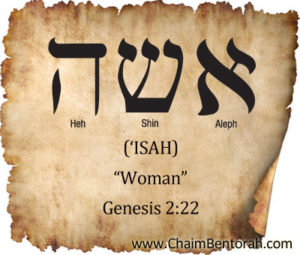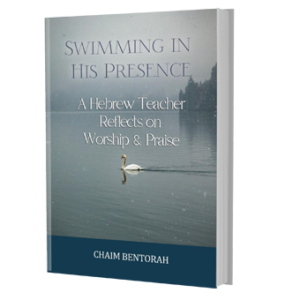HEBREW WORD STUDY – WOMAN – ‘ISAH אשׁה
Genesis 2:22: “And the rib, which the LORD God had taken from man, made He a woman, and brought her unto the man.”
 I am amazed at how protestant Bible translators cling to the rending of tesla as rib. Tesla is used 41 times in the Old Testament and only two times is it rendered as a rib. Twenty times it is rendered as side and 12 times as a side chamber. In its Semitic root the word tsela has the idea of limping, that is turning from side to side.
I am amazed at how protestant Bible translators cling to the rending of tesla as rib. Tesla is used 41 times in the Old Testament and only two times is it rendered as a rib. Twenty times it is rendered as side and 12 times as a side chamber. In its Semitic root the word tsela has the idea of limping, that is turning from side to side.
The Jewish sages teach God took one side of man, he split the man in half and formed a woman from one side and a man from the other side. He recreated this human into two separate beings from one being. From this God created an ishah or women. Contrary to what we find in Christian lexicons, Jewish lexicographers and linguist such as Rabbi Samson Hirsch point out that the root word for ishah is ‘ish when it is singular and nashah when it is in a plural form nashim. Woman and women are from two different root words. Nashah comes from the same root word as nushah which means a creditor. In the singular form the word for woman is the same as the word for a man, man and woman comes from the same root word. The singular word for woman ‘isah is also the word for wife.
It is explained this way, in the singular a woman’s relationship to man is that of a wife to a husband. Since man and woman comes from the same root word, she is not given over into his power, rather she complements him and stands at his side as an equal. The plural, however, expresses a public status of the woman. Only in a public status or the life a community does a woman give the appearance of being powerless, however, this is in the form of a nushah or creditor. A creditor loans part of his property or rights in return something. The woman gives up her rights in the public or community in return for the freedom to have the time to raise and care for her family.
This is very distinct from other creatures of the earth which are divided into male and female. In the case of other living creatures both sexes came forth independently from the earth. God did not create the female from the male and thus they do not need each other to fulfill their life’s purpose. Genesis 2:24 teaches only man devaq baishathu cleaves to his wife. The sages teach that only man is privileged with married life.
You see God did not declare the creation of man or the human being as good – tov until he created the woman and then this finished off His creation. You see the completion of the good, the tov or harmony with God was not with the creation of the human being or man, but with the creation of the woman. Woman was the last of God’s creation and it was that creation that created the good or harmony with God.
Maybe that is why women tend to be the most faithful to the church and service to God, they were the final piece to the puzzle of creation that put all of creation in harmony with God. For you see before Genesis 1:31 God declared everything as good, but after He created woman He declared everything kal all as tov mo’ed, very good, the complete and full good or harmony with God.







Recent Comments